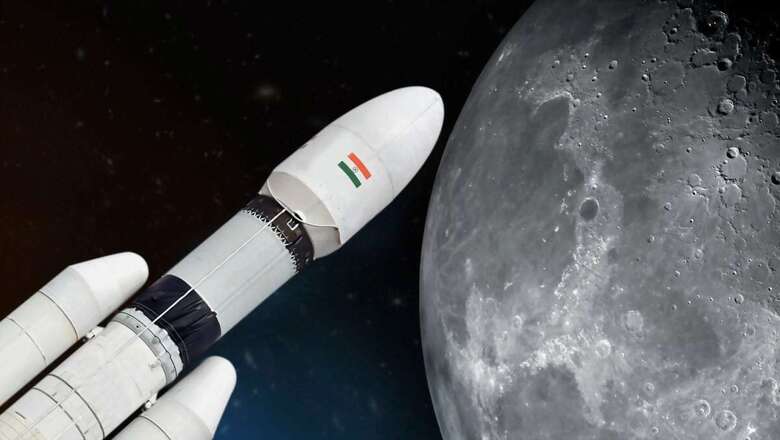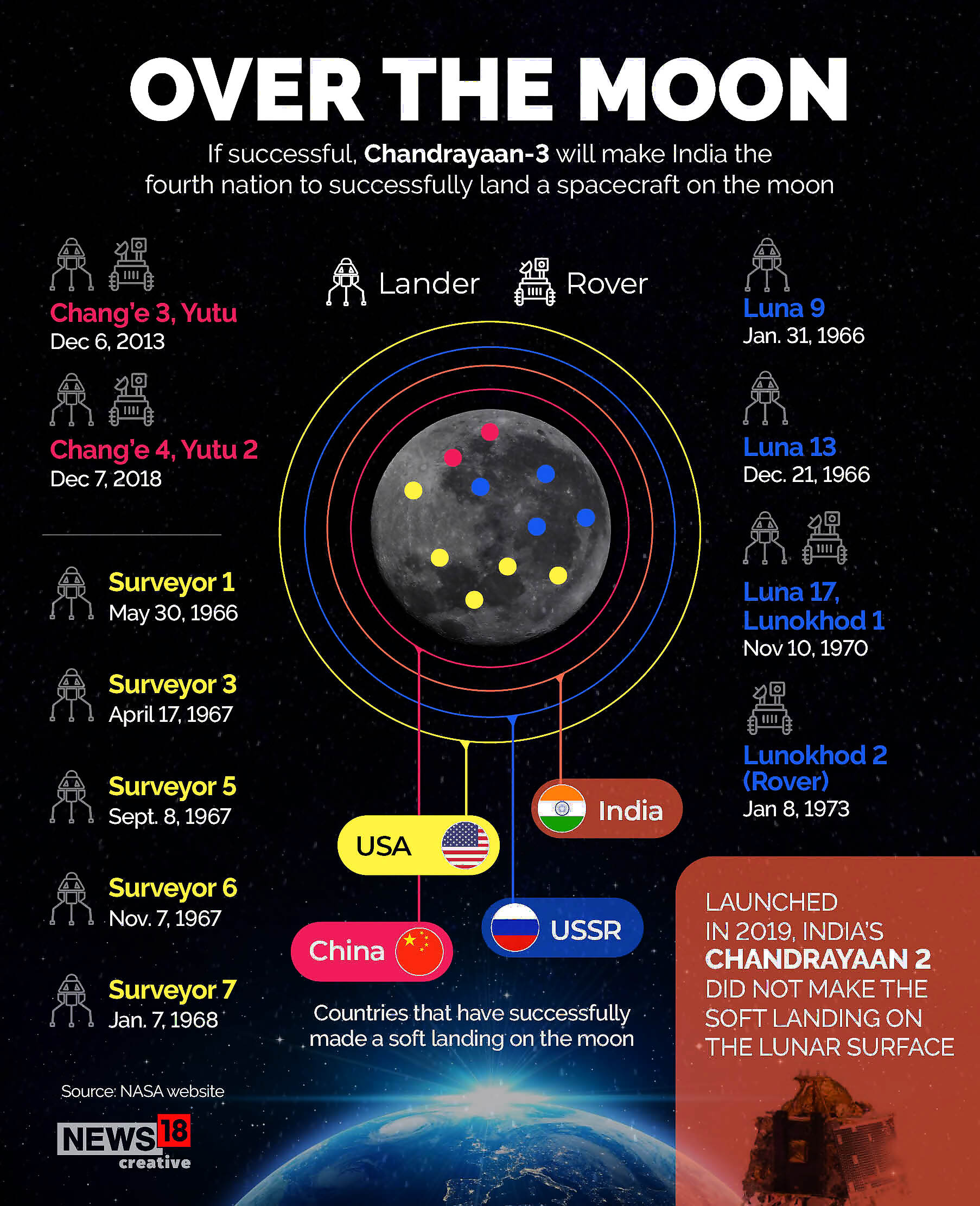
views
Chandrayaan-3 is all set for a successful landing on the south polar region of the Moon on Wednesday at 6:04 pm after completing its 40-day journey. The Indian Space Research Organisation (ISRO) said that Chandrayaan-3 mission is on schedule.
If the Chandrayaan-3 mission succeeds in making a touchdown on the moon and in landing a robotic lunar rover, India will become the fourth country to master the technology of soft-landing on the lunar surface after the US, China and the erstwhile Soviet Union.
History of Chandrayaan Missions
The Chandrayaan mission, also known as the Indian lunar exploration programme, involves a series of space missions conducted by ISRO. The first mission, Chandrayaan-1, was launched in 2008 and successfully entered lunar orbit.
Chandrayaan-2 had failed in its lunar phase when its lander ‘Vikram’ crashed into the surface of the Moon following anomalies in the braking system in the lander while attempting a touch down on September 7, 2019.

Chandrayaan-3 is a follow-on mission to Chandrayaan-2 and its objectives are to demonstrate safe and soft-landing on the lunar surface, roving on the Moon, and to conduct in-situ scientific experiments.
The Rs 600 crore Chandrayaan-3 mission was launched on July 14 onboard Launch Vehicle Mark-III (LVM-3) rocket, for a 41-day voyage to reach near the lunar south pole.
First Look of Chandrayaan-3
ISRO had showed the first glimpse of the third moon mission Chandrayaan-3 in April last year. Chandrayaan-3 was earlier scheduled to be launched in 2020, but it was delayed due to the COVID-19 pandemic.
Learning from its past instance, ISRO has implemented several improvements in Chandrayaan-3 in order to ensure success this time.
All About Chandrayaan 3
The Chandrayaan-3 spacecraft is the third lunar exploration mission planned by ISRO following the failed Chandrayaan-2 mission. The mission serves as a continuation of the Chandrayaan-2 mission in 2019 and aims to showcase the complete capability of safe landing and roving on the lunar surface.
Chandrayaan-3 consists of three parts: a Lander module (LM), Propulsion module (PM) and a Rover. The Lander has the capability to soft land at a specified lunar site and deploy the Rover which will carry out the research on the lunar surface.
The Lander and the Rover have scientific payloads to carry out experiments on the lunar surface. The main function of Propulsion module is to carry the Lander module from launch vehicle injection till final lunar 100 km circular polar orbit.
Chandrayaan-3’ Launch and ISRO’s Optimism
Chandrayaan-3 took off from the Satish Dhawan Space Centre in Andhra Pradesh from the Geosynchronous Satellite Launch Vehicle Mark III (GSLV-MK III) heavy-lift rocket on July 14, 2023.
The mission would help boost the government’s plan to spur investment in private space launches and related satellite-based businesses.
The significance of the Chandrayaan-3 mission is that the Propulsion Module has a payload- SHAPE or Spectro- polarimetry of Habitable Planet Earth to study Earth from lunar orbit, according to PTI.
Chandrayaan 3 Milestones
After the launch on July 14, Chandrayaan-3 conducted a series of orbit-raising manoeuvres to gradually move the spacecraft into higher and higher orbits before beginning to move directly towards the moon. The earth-bound manoeuvres went on till July 31 after which the craft moved into translunar orbit.
Chandrayaan-3 performed the Trans Lunar Injection (TLI), a propulsive manoeuvre to slingshot the spacecraft towards the Moon from Earth’s orbit on August 1. The propulsive manoeuvre sent the lunar craft on a trajectory towards the Moon.

Chandrayaan-3 entered into the lunar orbit on August 5, following which orbit reduction manoeuvres were carried out on the satellite on August 6, 9, 14 and 16.
On August 16, ISRO successfully carried out the fifth and final orbit reduction manoeuvre.
Vikram Lander Separation and Beyond
Chandrayaan-3 Lander Module (LM), comprising the Vikram lander and the Pragyan rover, successfully separated from the Propulsion Module on August 17.
After separation, the lander underwent a “deboost” (the process of slowing down) to place it in an orbit where the Perilune, the closest point to the Moon, is 30 kilometres and Apolune, the farthest point from the Moon, is 100 km.
After the second and final deboosting operation on August 20, the Landing Module is placed in a 25 km x 134 km orbit around the Moon. Finally, the touchdown of the Lander will be attempted on August 23 at 6:04 pm.
Chandrayaan 3 Engine
Chandrayaan-3 engine has been manufactured by Godrej Aerospace which is tucked away in a green zone along the Eastern Express Highway in the suburbs of Vikhroli. The plant has been one of the largest private manufacturers and suppliers for ISRO since 1985. Godrej Aerospace also had key contributions to Chandrayaan-1 and 2 and Mangalyaan space missions, besides participating in ISRO’s other endeavours.
Cost of Chandrayaan-3
Chandrayaan-3, with an estimated budget of Rs 615 crore, is said to be one of the most cost-effective space missions as compared to its predecessors.
Meanwhile, Chandrayaan-2, launched on July 22, 2019, was manufactured at a cost of Rs 978 crore, including Rs 603 crore for the orbiter, lander, rover, navigation and ground support network and Rs 375 crore for the heavy GSLV rocket with indigenous cryogenic engine.
Landing and Beyond
Chandrayaan-3 Lander Module will make a touchdown on the surface of the Moon at 6:04 pm on Wednesday. With less than 30 hours to go for the landing, the Lander Module of the lunar craft is trying to locate a spot for perfect landing on the Moon’s surface, which will lead to a historic landing.
The lunar mission is aimed at the southern polar region of the Moon, a region with water ice or frozen water, that could be a source of oxygen, fuel and water for future moon missions or a more permanent moon colony.
After landing successfully, the Chandrayaan-3 is expected to remain functional for two weeks, running a series of experiments including a spectrometer analysis of the mineral composition of the lunar surface.
Shortly after the touchdown, one side panel of the Vikram lander will unfold, creating a ramp for the Pragyan rover. The six-wheeled Pragyan with a national flag and ISRO logo will descend from the landed on the lunar surface after four hours and move at a speed of 1 cm per second. The payloads attached to the Lander and rover will carry out several study and send back data about the lunar surface, the processes of lunar body and its formation.















Comments
0 comment